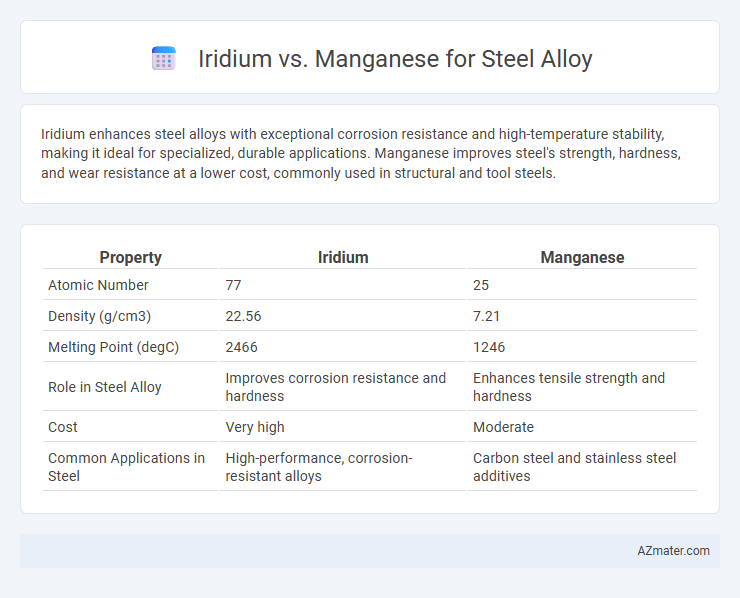Iridium enhances steel alloys with exceptional corrosion resistance and high-temperature stability, making it ideal for specialized, durable applications. Manganese improves steel's strength, hardness, and wear resistance at a lower cost, commonly used in structural and tool steels.
Table of Comparison
| Property | Iridium | Manganese |
|---|---|---|
| Atomic Number | 77 | 25 |
| Density (g/cm3) | 22.56 | 7.21 |
| Melting Point (degC) | 2466 | 1246 |
| Role in Steel Alloy | Improves corrosion resistance and hardness | Enhances tensile strength and hardness |
| Cost | Very high | Moderate |
| Common Applications in Steel | High-performance, corrosion-resistant alloys | Carbon steel and stainless steel additives |
Introduction to Steel Alloying Elements
Iridium and manganese are both critical steel alloying elements, each imparting unique characteristics to steel. Manganese primarily enhances hardness, tensile strength, and wear resistance by improving the steel's microstructure and deoxidizing properties, making it essential in carbon and low alloy steels. Iridium, though less common, increases corrosion resistance and high-temperature stability, benefiting specialized steels used in extreme environments and advanced industrial applications.
Overview of Iridium in Steel Alloys
Iridium is a rare and dense platinum-group metal used in steel alloys to enhance corrosion resistance and high-temperature strength. Its exceptional hardness and stability improve the durability of steel in harsh environments, making it valuable for specialized applications. Compared to manganese, which primarily improves toughness and wear resistance, iridium offers superior oxidation and chemical resistance, crucial for advanced industrial uses.
Overview of Manganese in Steel Alloys
Manganese is a crucial alloying element in steel production, enhancing hardness, tensile strength, and wear resistance while improving hot-working properties and deoxidation. It acts as a sulfur fixer, reducing brittleness caused by sulfur impurities, and helps prevent steel from cracking during processing. Compared to iridium, manganese is more cost-effective and widely used in steel alloys due to its abundant availability and significant contribution to improving mechanical properties and durability.
Chemical Properties: Iridium vs Manganese
Iridium exhibits exceptional chemical inertness and corrosion resistance due to its noble metal characteristics, forming stable oxide layers only at high temperatures. Manganese, in contrast, is highly reactive and prone to oxidation, playing a critical role as a deoxidizer and alloying agent that improves steel hardness and wear resistance. The chemical stability of iridium contrasts with the active chemical participation of manganese, influencing their distinct effects on steel alloy performance.
Mechanical Impact on Steel Performance
Iridium enhances steel alloy performance by significantly improving corrosion resistance and toughness due to its high density and strong atomic bonding, which contributes to greater wear resistance and longevity. Manganese plays a critical role in increasing the hardenability and tensile strength of steel, promoting better ductility and impact resistance during mechanical stress. The combination of iridium's durability and manganese's strengthening properties optimizes steel's mechanical resilience for high-stress applications.
Corrosion Resistance Comparison
Iridium exhibits superior corrosion resistance compared to manganese when used in steel alloys due to its high chemical stability and inertness, especially in acidic and oxidative environments. Manganese, while beneficial for enhancing hardness and tensile strength, is more prone to oxidation and corrosion, often requiring protective coatings or treatments. Therefore, steel alloys containing iridium maintain durability and resist degradation longer under harsh conditions, making them ideal for specialized applications where corrosion resistance is critical.
Cost and Availability Considerations
Iridium is significantly more expensive and rarer than manganese, making it less practical for widespread use in steel alloy production. Manganese is abundant, cost-effective, and essential for improving steel's hardness and durability. Choosing manganese over iridium minimizes material expenses and ensures sustainable supply for industrial steel manufacturing.
Industrial Applications and Use Cases
Iridium, known for its exceptional corrosion resistance and high melting point, is primarily used in specialized industrial applications such as spark plugs, crucibles, and electrical contacts in harsh environments, where durability and chemical stability are critical. Manganese, crucial for steel alloys, serves as a deoxidizer and alloying element that significantly improves tensile strength, hardness, and wear resistance, making it essential in construction, automotive manufacturing, and heavy machinery industries. The industrial preference for manganese in steel production is due to its cost-effectiveness and effectiveness in enhancing mechanical properties, whereas iridium's applications are more niche, focusing on extreme conditions requiring superior corrosion resistance and durability.
Environmental and Safety Aspects
Iridium offers superior corrosion resistance and stability in steel alloys, reducing the need for frequent replacements and minimizing environmental waste. Manganese, while essential for improving steel strength and toughness, can pose occupational health risks during processing due to manganese dust inhalation, necessitating rigorous safety measures. The lifecycle impact of iridium, including its scarce availability and energy-intensive extraction, contrasts with manganese's abundance and lower environmental footprint, influencing sustainable alloy selection in steel manufacturing.
Choosing the Right Element: Iridium or Manganese
Iridium offers exceptional corrosion resistance and high-temperature stability, making it ideal for specialized steel alloys in aerospace and chemical industries. Manganese enhances steel strength, toughness, and wear resistance, serving as a cost-effective alloying element widely used in structural and engineering steels. Selecting the right element depends on application-specific requirements, balancing performance benefits with economic considerations.

Infographic: Iridium vs Manganese for Steel Alloy
 azmater.com
azmater.com